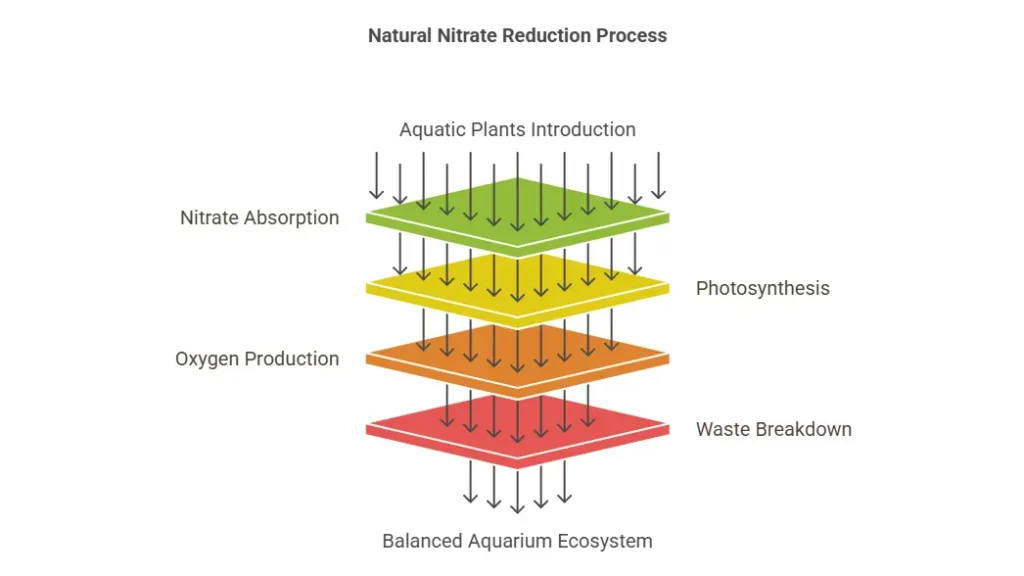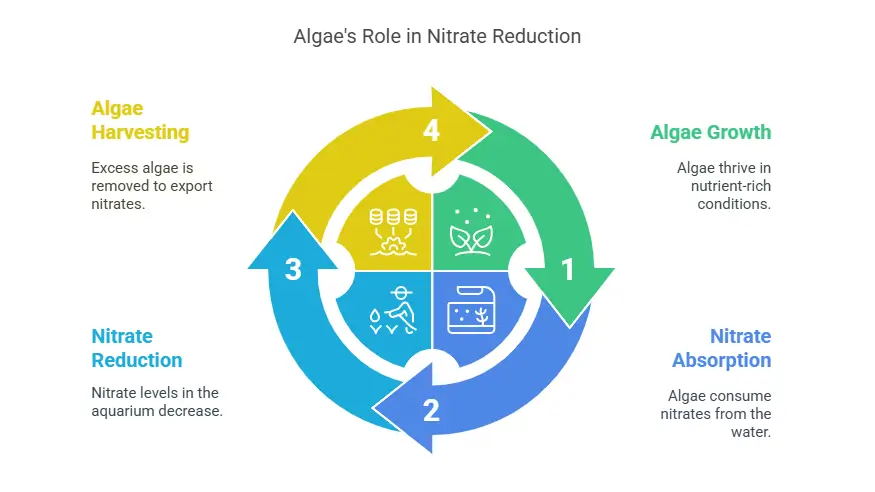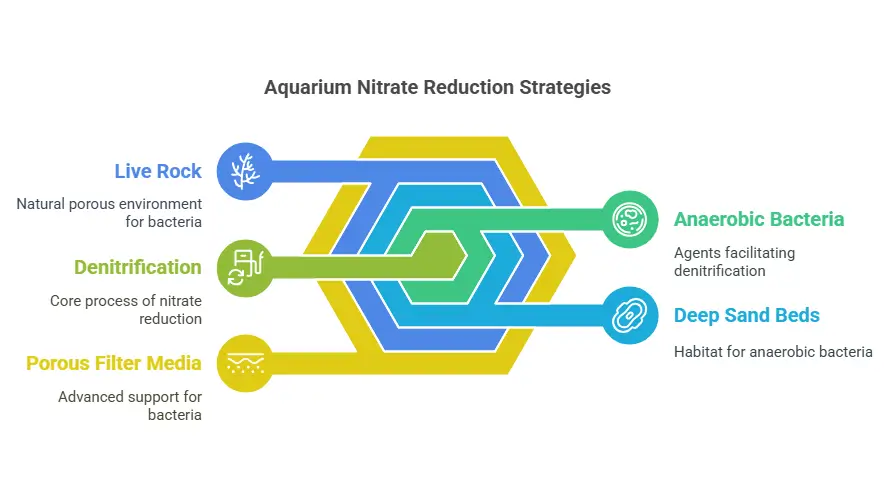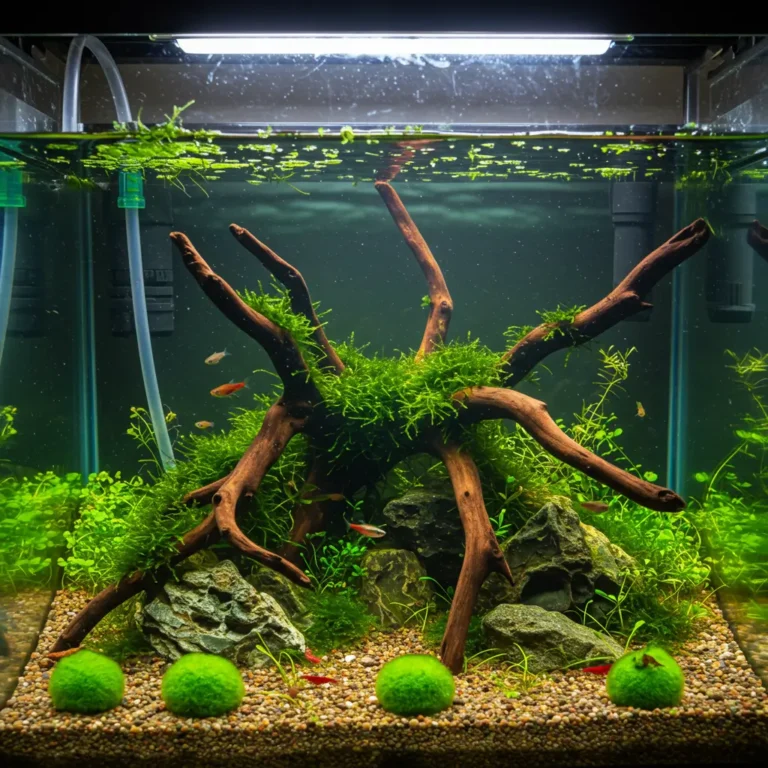Well hello there, fellow water gardeners! Susan here, and if there’s one thing my years in the soil have taught me, it’s that a thriving ecosystem, whether it’s a sprawling vegetable patch or a shimmering fish tank, hinges on balance.
Just as we strive for the perfect harmony of nutrients in our garden beds, so too must we pay attention to the unseen forces at work in our aquariums. You might be noticing that your underwater world needs a little help, specifically when it comes to those pesky nitrates.
Table of Contents
Now, for those new to the hobby, let’s talk a bit about what these nitrates are. In essence, they’re the final stage of the natural nitrogen cycle that occurs in every healthy aquarium. Fish waste and uneaten food break down into ammonia, which beneficial bacteria then convert into nitrites, and finally into nitrates.
While nitrates are considerably less harmful to your finned friends than ammonia or nitrites, which can be quite toxic even in small amounts, letting nitrate levels climb too high is far from ideal. Think of it like too much of a good thing in the garden – even essential nutrients can become problematic in excess, sometimes encouraging unwanted algae growth and potentially stressing your aquatic inhabitants.
So, you’re looking for ways to reduce nitrates in fish tank naturally, and you’ve come to the right place! Just as I favor organic methods in my garden, there are several effective and gentle ways to lower nitrate levels in your aquarium without resorting to harsh chemicals.
In this blog post, we’ll delve into 5 natural methods that work wonders to reduce fish tank nitrates, helping you cultivate a healthier and more vibrant environment for your beloved aquatic life. Whether you’re dealing with persistently high nitrate readings or simply want to take a more holistic approach to aquarium maintenance, the information shared here will provide you with practical, time-tested strategies to reduce nitrates in your aquarium effectively and naturally. Let’s get started on creating a balanced and beautiful underwater garden, shall we?
Method 1: The Cornerstone – Regular and Responsible Water Changes

Ah, my dear aquarium enthusiasts! I’m ready to share some tried-and-true wisdom. Just like tending a garden where regular weeding and refreshing the soil are key to a flourishing landscape, maintaining a balanced aquarium relies heavily on consistent care. And when it comes to keeping those nitrate levels in check, there’s one method that stands head and shoulders above the rest: regular and responsible water changes. Think of it as giving your underwater world a refreshing drink and a bit of a clean sweep all in one!
Now, you might be wondering, “Why are water changes so crucial when I want to reduce nitrates in my fish tank?” Well, it’s quite simple, really. Nitrates are the natural end product of the nitrogen cycle in your aquarium. While less harmful than ammonia and nitrites, letting them build up too much is like letting fallen leaves pile up in your garden – eventually, they can create an imbalance and stress your plants (or in this case, your fish!).
The most direct and reliable way to lower nitrate levels is by physically removing the nitrate-rich water and replacing it with fresh, clean water. It’s akin to diluting a strong fertilizer solution – you’re reducing the concentration of nitrates in the overall volume of your aquarium.
So, how often should you be reaching for that siphon and bucket to reduce aquarium nitrates effectively? The frequency and volume of your water changes will depend on several factors, including the size of your tank, the number of fish you have (your tank’s bioload), how much you feed them, and the effectiveness of your filtration system.
Here are some general guidelines to consider for your regular water change routine aimed at reducing nitrates in your fish tank:
- Consistency is Key: Aim for a regular schedule. Whether it’s weekly, bi-weekly, or monthly, establishing a routine will help prevent drastic nitrate spikes.
- Percentage Matters: Many experienced aquarists recommend changing 20% to 50% of the water in your established tank. Some even find that more frequent, smaller changes (like 20-30% weekly) or less frequent, larger changes (like 50% bi-weekly) can be effective. The key is to monitor your nitrate levels and adjust accordingly.
- Test Your Source Water: Before you even begin, it’s vital to test your tap water for nitrates. If your tap water already has a high nitrate concentration (some sources suggest above 40 ppm), you might be inadvertently adding to the problem! In such cases, you might consider using reverse osmosis (RO) water for your changes, as it’s typically free of nitrates and other impurities.
- Preparation is Paramount: Always ensure that the new water you’re adding is properly treated to remove chlorine and chloramine, which are harmful to your fish and beneficial bacteria. Matching the temperature of the new water to the aquarium water is also crucial to avoid stressing your aquatic inhabitants.
- Beyond Nitrates: Remember that water changes aren’t just about nitrate reduction. They also help to replenish essential minerals in the water, remove other dissolved organic compounds, and maintain overall water quality.
In essence, think of regular water changes as the foundational step in maintaining a healthy and balanced aquarium environment and the most straightforward way to reduce nitrates in fish tank. It’s a simple yet incredibly effective practice that will go a long way in keeping your finned friends happy and your underwater garden thriving. So, embrace the routine – your fish will thank you for it!
Method 2: Nature’s Filters – The Power of Live Aquatic Plants

Well now, let’s get our hands a little wet and talk about another wonderful way to bring balance to your underwater ecosystem! And just as I rely on the green wonders of my garden to enrich the soil and purify the air, you can harness the power of live aquatic plants to naturally reduce nitrates in fish tank. Think of them as nature’s tiny water gardeners working tirelessly within your aquarium!
For those looking to lower nitrate levels in a gentle and sustainable way, introducing aquatic plants is a truly beautiful and effective solution. Much like my prize-winning tomatoes need nitrogen to flourish in the garden, live aquarium plants utilize nitrates as a vital nutrient for their growth. As they photosynthesize and develop new leaves and roots, these underwater greens actively absorb nitrates from the water column, essentially providing a natural form of filtration. It’s a symbiotic relationship – your fish produce waste that breaks down into nitrates, and your plants use those nitrates to thrive, leading to a healthier environment for everyone.
Now, not all aquatic plants are created equal when it comes to nitrate reduction. Just as some garden vegetables are heavier feeders than others, certain fast-growing plants are particularly efficient at uptaking nitrates. Some excellent choices for freshwater tanks known for their ability to reduce nitrates in fish tank include:
- Water Sprite (Indian water Fern): A low-maintenance and attractive plant that efficiently absorbs nitrates, ammonia, and nitrites.
- Duckweed: These small floating plants multiply quickly and are excellent at naturally reducing nitrates. Do keep an eye on them, though, as they can spread rapidly.
- Water Wisteria: A visually appealing and easy-to-grow plant that effectively consumes nitrates.
- Frogbit: Similar to duckweed, frogbit is a floating plant with extensive roots that offer refuge for fish and effectively take up nitrates.
- Hornwort: A great option for tanks with high nitrate levels due to its high absorption rate.
- Anacharis (Elodea): Not only an effective nitrate remover but also a food source for some freshwater fish.
- Water Lettuce: Another floating plant that can efficiently collect nitrogen, thus helping to reduce nitrates in the tank water.
For saltwater aquariums, certain macroalgae like Chaeto (Chaetomorpha linum or crassa) are known for their rapid growth and ability to absorb significant amounts of nitrates. You can even grow this in a separate refugium, harvesting it to remove the absorbed nitrates from the system. Mangroves and other algae varieties also contribute to nitrate reduction in saltwater environments.
However, just like any element in your garden, live aquatic plants need the right conditions to thrive and effectively reduce aquarium nitrates. Ensure your plants receive adequate lighting, appropriate substrate if they are root feeders, and consider supplementing with plant fertilizers if needed, although be mindful of the nitrate content in those fertilizers. Importantly, always remove any dead or decaying plant matter promptly, as this can break down and add nitrates back into your aquarium.
Beyond their crucial role in nitrate reduction, live plants offer a wealth of benefits to your fish tank. They provide natural hiding places and spawning grounds for your fish, contribute to oxygen production, and enhance the overall beauty and natural feel of your underwater landscape.
So, if you’re seeking a natural, aesthetically pleasing, and multifaceted approach to reduce nitrates in fish tank, consider embracing the power of live aquatic plants. It’s like bringing a little piece of nature’s ingenuity right into your home aquarium!
Method 3: Less is More – Reducing Waste Production

Alright, let’s roll up our sleeves and delve into another fundamental aspect of maintaining a healthy aquarium, one that resonates deeply with any gardener’s philosophy: less is more. And just as we aim to minimize waste in our gardens through composting and thoughtful planting, we can significantly reduce nitrates in our fish tank by simply producing less waste to begin with. It’s a gentle approach that works wonders!
Think of it this way: in the garden, if we over-fertilize, we don’t just get more beautiful blooms; we can end up with leggy growth, susceptibility to pests, and an imbalance in the soil. Similarly, in our aquariums, excess organic matter – primarily from uneaten food and fish waste – is the very fuel that drives the nitrogen cycle, ultimately leading to the accumulation of nitrates. Therefore, one of the most effective ways to lower nitrate levels is to address the source: the production of waste.
There are two key areas where we can make a real difference in reducing waste production in our fish tanks:
- Mindful Feeding: Oh, it’s tempting to generously sprinkle food and watch our finned friends eagerly devour it, isn’t it? But just like leaving piles of uneaten fertilizer in the garden, overfeeding your fish is a surefire way to elevate those nitrate readings. Fish should be given only the amount of food they can completely consume within a few minutes. Any leftover food will decompose, adding to the ammonia load and subsequently the nitrate buildup. Consider these tips for more mindful feeding to reduce fish tank nitrates:
- Observe your fish during feeding: Note how much they eat and adjust portions accordingly for future feedings.
- Feed sparingly: A good rule of thumb is to feed once or twice a day, and only a small pinch at a time. Some aquarists even fast their fish one day a week to further reduce waste.
- Turn off filters during feeding: This prevents food from being immediately sucked into the filtration system where it can decompose without being eaten.
- Vacuum your substrate regularly: Even with careful feeding, some food particles may sink to the bottom. Using an aquarium vacuum during water changes will remove this detritus before it significantly contributes to nitrate levels.
- Responsible Stocking Levels: Just as planting too many seedlings in a small space can lead to overcrowding and stressed plants in the garden, overstocking your fish tank will inevitably lead to a higher bioload – meaning more fish waste. More waste translates directly to higher nitrate levels. To effectively reduce nitrates in your aquarium, it’s crucial to ensure you have an appropriate number of fish for the size of your tank and the capacity of your filtration system. Consider the adult size of your fish when making stocking decisions, not just their size when you bring them home. A small, seemingly harmless fish can grow quite large and produce significantly more waste. Maintaining fewer fish, without overfeeding them, can lessen the quantity of ammonia, fish waste, and subsequent nitrate produced.
By focusing on these two core principles – feeding with care and maintaining appropriate stocking levels – you’ll be taking a significant step towards naturally reducing nitrates in your fish tank. It’s all about creating a balanced environment where less waste means less work for your beneficial bacteria and a healthier, more stable underwater world for your beloved aquatic life. Remember, sometimes, in both gardening and fishkeeping, the most impactful changes come from simply doing less of what causes the problem in the first place!
Method 4: The Algae Ally – Exploring Algae’s Role in Nitrate Uptake

Let’s explore another fascinating aspect of keeping a balanced and thriving aquarium. Just as we sometimes find unexpected allies in our gardens, today we’ll delve into the often-misunderstood world of algae and how it can actually help us reduce nitrates in fish tank.
I can almost hear some of you: ‘But algae? Isn’t that the bane of every aquarium keeper’s existence?” And while excessive algae can certainly be a nuisance, in a controlled manner, algae can become a valuable partner in our efforts to lower nitrate levels naturally. Think of it as utilizing nature’s own little nitrate consumers!
You see, just like the prized plants in your garden, algae require nutrients to grow, and one of their primary food sources is – you guessed it – nitrates. As these simple aquatic organisms photosynthesize, they actively absorb nitrates from the water column, effectively helping to reduce fish tank nitrates. It’s a biological process, plain and simple, much like how my herbs draw nutrients from the soil.
There are a few key ways we can harness this natural nitrate uptake by algae to benefit our aquariums:
- The Algae Turf Scrubber (ATS): This is a dedicated system designed to encourage the growth of beneficial algae. Typically, it involves a screen or other surface that is illuminated with a strong light and has aquarium water flowing over it. The algae that grows on this surface readily consumes nitrates and other unwanted nutrients from the water. By regularly “harvesting” or cleaning this algae mat, you physically remove the nitrates that the algae have absorbed from your fish tank water. While more commonly used in saltwater tanks, the principle of nutrient uptake remains the same for freshwater systems as well.
- Refugiums with Macroalgae: Especially popular in saltwater aquariums, a refugium is a separate, smaller tank connected to the main display tank. This refuge often houses fast-growing macroalgae like Chaeto (Chaetomorpha). These types of algae are incredibly efficient at absorbing nitrates. Because the refugium provides a safe haven from grazing fish, the macroalgae can flourish and significantly contribute to reducing nitrates in the entire aquarium system. Periodically, you can remove some of the macroalgae, effectively exporting the absorbed nitrates.
- Controlled Algae Growth in the Main Tank: While we don’t want an explosion of unsightly algae, a thin layer of green algae on the tank walls or decorations can actually be a sign of a healthy, functioning ecosystem where some natural nitrate reduction is occurring. Of course, we need to keep this growth in check through regular maintenance to maintain visibility and prevent overgrowth.
It’s important to remember that while algae can be a valuable ally in our efforts to reduce aquarium nitrates, it’s not a standalone solution. Just like relying solely on one type of plant to amend your garden soil isn’t ideal, using algae for nitrate control works best in conjunction with other good aquarium practices, such as regular water changes and responsible feeding habits.
Furthermore, the effectiveness of algae in lowering nitrate levels depends on factors like light intensity, nutrient availability (including nitrates and phosphates), and the surface area available for algae growth. Providing the right conditions will encourage healthy algae growth and maximize its nitrate removal potential.
So, the next time you see a bit of green in your aquarium, don’t immediately reach for the scrub brush. Consider that you might have a tiny, natural helper at work, assisting you in maintaining a healthy and balanced environment for your fish by contributing to the process of reducing nitrates in the fish tank. It’s all part of the beautiful interconnectedness of nature, even within the confines of our glass boxes!
Method 5: The Hidden Helpers – Anaerobic Bacteria and Denitrification

Now we’re going to delve into a slightly more mysterious, yet incredibly helpful, aspect of keeping a balanced aquarium. Just like the unseen microbes in our garden soil diligently break down organic matter, our fish tanks have their own hidden helpers working tirelessly beneath the surface to reduce nitrates in fish tank: anaerobic bacteria.
Now, we’ve already discussed methods like mindful feeding and the algae ally, which focus on limiting nitrate production or actively absorbing it. But nature has another clever trick up its sleeve, a process called denitrification, carried out by these remarkable anaerobic bacteria. To understand how they help us lower nitrate levels, let’s briefly revisit the nitrogen cycle. Fish waste and uneaten food break down into ammonia, which is then converted to nitrite, and finally to nitrate by beneficial aerobic bacteria – bacteria that thrive in oxygen-rich environments. Nitrate, while less toxic than ammonia and nitrite, can still accumulate and become problematic for our fish and corals.
This is where our hidden heroes, the anaerobic bacteria, step in. These fascinating microorganisms thrive in environments with little to no oxygen. In these oxygen-depleted zones within our aquariums, certain types of bacteria can actually use nitrate instead of oxygen for respiration, effectively converting the nitrate into harmless nitrogen gas, which then escapes into the atmosphere. This natural process, denitrification, is a fantastic way to naturally reduce nitrates in fish tank.
So, how can we encourage these beneficial anaerobic bacteria to set up shop in our underwater worlds and help us lower nitrate levels? There are a few key strategies we can employ:
- Deep Sand Beds: Think of a deep layer of fine sand, around 3 to 6 inches, in a less disturbed area of your tank. The deeper layers of this sand bed become oxygen-poor, creating the perfect habitat for anaerobic bacteria to flourish and carry out denitrification. However, it’s crucial to avoid disturbing these deep sand beds excessively, as this can release trapped gases and potentially impact water quality.
- Live Rock: For saltwater aquariums, live rock is a powerhouse of beneficial microorganisms, both aerobic and anaerobic. The porous structure of live rock creates varying oxygen levels, with the inner sections often becoming anoxic, providing a home for denitrifying bacteria to contribute to nitrate reduction.
- Porous Filter Media: Modern aquarium technology offers specialized filter media designed with extensive surface area and deep, interconnected pores. These advanced media, such as MarinePure®, can support a large population of both aerobic bacteria on the outer surfaces and anaerobic bacteria within the deeper recesses, facilitating the entire nitrogen cycle, including the crucial step to reduce nitrates in fish tank.
- Denitrators: There are also specialized pieces of equipment called denitrifiers that create ideal low-oxygen conditions for denitrification to occur.
Now, while these hidden helpers are a wonderful natural way to reduce nitrates in your aquarium, it’s important to remember that establishing a thriving population of anaerobic bacteria takes time and the right conditions. It’s not an instant fix, and it works best as part of a holistic approach to aquarium maintenance.
Just like in gardening, where we rely on a multitude of factors for a healthy ecosystem, relying solely on anaerobic bacteria to lower nitrate levels isn’t always the most reliable or sufficient method. Regular water changes remain a cornerstone of good aquarium keeping and are a direct and effective way to physically remove nitrates. Moreover, water changes also replenish essential minerals that your aquatic inhabitants need. Responsible feeding habits and appropriate stocking levels, as discussed previously, will also significantly impact the amount of nitrate produced in the first place.
In conclusion, the hidden world of anaerobic bacteria and the process of denitrification offer a fascinating and natural way to contribute to the reduction of nitrates in your fish tank. By understanding how to create suitable environments for these microscopic allies, we can further enhance the health and stability of our aquariums. However, remember that these hidden helpers work best in concert with other sound aquarium husbandry practices. Until our next exploration.
Conclusion
Well, there you have it, friends! wrapping up our exploration into the fascinating world of how to reduce nitrates in fish tank. Just like tending a garden, maintaining a healthy aquarium requires a multifaceted approach, and thankfully, nature offers us several wonderful tools.
We’ve journeyed through various methods, from the simple yet crucial act of regular water changes – think of it as refreshing the soil for your underwater plants – to the vital role of live aquatic plants acting as natural nitrate consumers, much like the vegetables and herbs in our gardens utilize nutrients. We’ve also considered the strategic use of algae, our often-underappreciated algae allies in nitrate uptake, and the hidden work of anaerobic bacteria, quietly performing denitrification in oxygen-poor zones to further reduce fish tank nitrates.
It’s important to remember, just as a healthy garden relies on well-draining soil, adequate sunlight, and the right balance of nutrients, a thriving aquarium needs consistent attention to all aspects of its environment. No single method is a magic bullet to reduce nitrates in your aquarium. Instead, the most effective strategy involves a combination of these techniques, tailored to your specific tank setup and inhabitants.
Here are a few key takeaways to keep in mind as you work to lower nitrate levels and maintain a healthy aquarium:
- Regular maintenance is paramount. Consistent water changes remain one of the most direct and effective ways to remove nitrates.
- Embrace the power of plants. Live aquatic plants are not only beautiful additions to your tank but also actively consume nitrates as they grow.
- Consider a balanced approach to algae. While excessive algae can be a problem, controlled algae growth, like in an algae turf scrubber, can aid in nitrate reduction.
- Encourage beneficial bacteria. Providing the right conditions for both aerobic and anaerobic bacteria supports the entire nitrogen cycle, including the conversion of nitrates into harmless nitrogen gas. Deep sand beds and porous filter media can help foster anaerobic bacteria.
- Monitor your water parameters. Regular testing will help you understand your tank’s nitrate levels and determine the effectiveness of your chosen methods. Aim to keep nitrate levels at an appropriate level for your specific fish and invertebrates.
- Prevent excessive nitrate production. Mindful feeding habits and appropriate stocking levels are crucial first steps in managing nitrates.
Just like nurturing a flourishing garden takes time and attention, maintaining a healthy, low-nitrate aquarium is an ongoing process. By understanding the natural cycles at play and employing a combination of these methods, you can create a balanced and thriving underwater environment for your finned friends. Happy fishkeeping!

